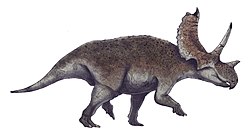Agujaceratops
| Agujaceratops | |
|---|---|

| |
| Partial holotype skull, Texas Science & Natural History Museum | |
| Scientific classification | |
| Domain: | Eukaryota |
| Kingdom: | Animalia |
| Phylum: | Chordata |
| Clade: | Dinosauria |
| Clade: | †Ornithischia |
| Clade: | †Ceratopsia |
| Family: | †Ceratopsidae |
| Subfamily: | †Chasmosaurinae |
| Genus: | †Agujaceratops Lucas, Sullivan & Hunt, 2006 |
| Type species | |
| †Agujaceratops mariscalensis (Lehman, 1989)
| |
| Species | |
| |
| Synonyms | |
| |
Agujaceratops (meaning "horned face from Aguja") is a
Discovery and species



In 1938, three dinosaur bone beds were excavated, and ceratopsian material was collected from
Originally described as Chasmosaurus mariscalensis by Lehman in 1989, subsequent analysis resulted in the taxon being put in its own genus. Agujaceratops was named by Spencer G. Lucas, Robert M. Sullivan and Adrian Hunt in 2006, and the type species is Agujaceratops mariscalensis.[3]
Later, Lehman and colleagues revisited the Agujaceratops material and found substantial variation. They described the Rattlesnake Mountain skull as a new species, Agujaceratops mavericus.[4]
Description

Agujaceratops was a relatively large horned dinosaur, reaching 4.3 metres (14 ft) in length and 1.5 metric tons (1.7 short tons) in body mass.[5] It was similar to other chasmosaurines such as Pentaceratops in having a short nose horn, long brow horns, and an elongate frill circled by small hornlets. The back of the frill has a strong notch, as in Pentaceratops and Chasmosaurus, giving it a heart shape, with three or four pairs of spike-like hornlets. The edges of the frill bear numerous low, blunt hornlets, giving it a strongly scalloped appearance. The brow horns are oriented up and out, and curve backwards in side view.[4]

Two species are known, Agujaceratops mariscalensis and A. mavericus. A. mariscalensis has shorter brow horns and a shorter frill.[4]
Ecology
Like other ceratopsids, Agujaceratops was a four-legged plant eater. The elaborate frill and horns suggest a complex social life, perhaps involving displays towards and fights with other members of the species over territory or mating. Multiple individuals are found in a single quarry. It is unclear whether this represents animals brought together by a drought or flood event, or perhaps a herd. Although it is common to find multiple individuals of centrosaurine ceratopsids together - large bonebeds are known for Centrosaurus and Pachyrhinosaurus, for example - bonebeds are rarer for chasmosaurines.[citation needed]
At the time, the Aguja Formation lay along the western margin of the Western Interior Seaway. The habitat Agujaceratops lived in (at least where the fossil material was found) may have been a swamp, due to the nature of the sediments.[citation needed]
Agujaceratops lived alongside a fauna that included the feathered dinosaur Leptorhynchos gaddisi and the small pachycephalosaur Texacephale. Predators would have included tyrannosaurs and the giant crocodilian Deinosuchus riograndensis.[citation needed]
See also
References
- .
- .
- ^ Lucas, S.G.; Sullivan, R.M.; Hunt, A.P. (2006). "Re-evaluation of Pentaceratops and Chasmosaurus (Ornithischia: Ceratopsidae) in the Upper Cretaceous of the Western Interior" (PDF). New Mexico Museum of Natural History and Science Bulletin. 35: 367–370.
- ^ S2CID 88907183.
- ISBN 978-0-691-16766-4.
- Dodson, P. (1996). The Horned Dinosaurs. Princeton University Press, Princeton, New Jersey. ISBN 0-691-05900-4.
External links
- DinoGeorge's List of Dinosaurs, including Agujaceratops Archived 2011-07-15 at the Wayback Machine
- Brief mention of Agujaceratops on the DML Archived 2016-03-03 at the Wayback Machine and here as well Archived 2016-03-03 at the Wayback Machine
- Texas archosaurs, including Chasmosaurus (now Agujaceratops)